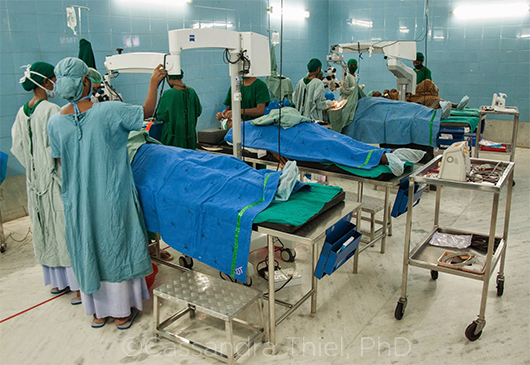Download PDF
This month, News in Review Highlights selected papers from the original papers sessions at AAO 2016. Each was chosen by the session chair because it presents important news or illustrates a trend in the field. Only 4 subspecialties are included here; papers sessions will also be held in 6 other fields. See the Meeting Program, which you’ll find in your meeting bag, or the Mobile Meeting Guide for more information.
Being “green” in the OR does not go hand-in-hand with poor outcomes. A recent comparison of materials, waste, and costs associated with phacoemulsification between India and the United States found that while cost and the carbon footprint differed dramatically, patient outcomes were similar.
Striking differences in waste and carbon footprints. Aravind Eye Hospital in India generated an average of 0.25 kg of waste per phacoemulsification procedure, two-thirds of which is recycled. In contrast, the 3 participating U.S. medical centers generated 2.3 to 3.9 kg of waste per case, all of it landfill or biohazardous material.
The study, conducted by Cassandra Thiel, PhD, assistant professor at New York University School of Medicine, uncovered other disparities as well. The cost of single-use surgical supplies was $380 per surgery in the United States, versus $7 in India.
Moreover, the carbon footprint of surgery at Aravind was about 5% that of the same procedure in the U.S. institutions studied.
Although Dr. Thiel expected to find differences between the countries, the range of costs and materials used between U.S. locations (and even within the same health system) surprised her, “considering phaco is a fairly standardized procedure.”
 |
OR IN INDIA. In the Aravind Eye Hospital OR, the surgical gowns and drapes for cataract surgery are reusable, except for a single disposable face drape.
|
Emphasis on reuse. The Aravind system minimizes single-use items: In contrast to U.S. practice, all gowns and drapes for cataract surgery are made of reusable materials, except for 1 disposable face drape. Most surgical instruments are also reusable, and pharmaceutical products are multiuse.
Recommendations for physicians. Dr. Thiel offers the following advice to physicians who want to reduce waste:
- Tell your surgical team that you want to minimize waste.
- Before opening surgical packs or supplies, confirm that the item is necessary.
- Ask your facility to switch to reusable instruments and supplies where appropriate.
- Encourage proper waste sorting or recycling and instrument reprocessing.
- Check out Health Care Without Harm and/or Practice Greenhealth for more ideas.
Many factors contribute to the disparity between India and the United States, with litigious and regulatory issues topping the list, said Dr. Thiel. Although there is a justified concern about infection in the OR, she said, “Aravind demonstrates that properly treated reusable materials can be just as effective as disposable materials and far more frugal.”
—Miriam Karmel
| Comparison of Cataract Surgical Wastes and Their Associated Costs in Both the United States and India. When: Sunday, Oct. 16, 11:30-11:37 a.m., during the first cataract original papers session (10:30 a.m.-12:10 p.m.). Where: S405. Access: Free. |
___________________________
Relevant financial disclosures: Dr. Thiel—Eye and Ear Foundation, Pittsburgh, Penn.: S; Prevent Blindness, New York: S. Dr. Thiel’s work on this project was supported with a Fulbright-Nehru Academic and Professional Excellence Award.
See the disclosure key at www.aao.org/eyenet/disclosures.
More from this month’s News in Review